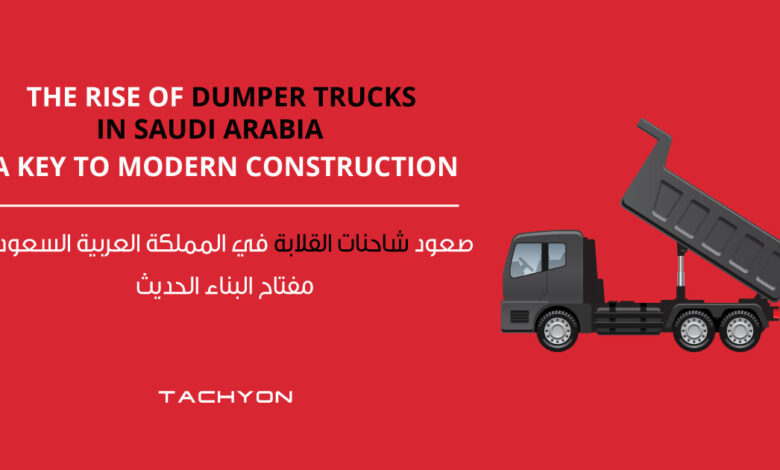The Rise of Dumper Trucks in Saudi Arabia: A Key to Modern Construction

Saudi Arabia’s construction industry has entered a new era of growth driven by ambitious projects like NEOM, The Line, Qiddiya, and extensive urban expansions in Riyadh and Jeddah. In this rapid development phase, dumper trucks—also known as site dumpers or articulated dump trucks—are emerging as vital equipment for managing large-scale earthworks, material hauling, and site preparations efficiently and safely. By combining versatility, payload capacity, and maneuverability, dumper trucks are transforming construction logistics and enabling faster completion of complex projects in challenging environments.
Understanding the Role of Dumper Trucks on Construction Sites
What Makes Dumper Trucks Essential
Dumper trucks are engineered to haul bulk materials—sand, gravel, rock, concrete—across job sites where typical haul trucks cannot operate. With robust wheels, high ground clearance, and self-contained hydraulics, they traverse uneven terrain effortlessly. Their front-loading capability and tilting skip design allow rapid loading by loaders or excavators, efficient transport across rough terrain, and fast, automated dumping at target locations.
Versatility Across Project Types
From residential building sites and road construction to mining and infrastructure developments, dumper trucks are well-suited to a variety of tasks. Their compact build lets them navigate tight spaces like narrow access roads or confined urban zones. Saudi mega-projects often combine heavy machinery with compact logistics needs, making dumper trucks an ideal choice for on-site material transport.
Trends Driving Adoption in Saudi Construction
Increasing Scale of Earthworks
Saudi construction projects are defined by extensive excavation and land shaping, particularly in desert terrains. Roads, bridges, underground utilities, and site foundations require millions of cubic meters of fill. Dumper trucks accelerate this workload by enabling continuous loading and dumping cycles, outperforming traditional methods like multi-dump/load bucket or dump trailers.
Doing More with Less Workforce
Rising labor costs and the need for skilled operators have made automation and mechanization priorities. Dumper trucks streamline material transport by reducing labor-intensive loading and hauling tasks, enhancing speed, productivity, and site safety.
Key Features That Matter in Saudi Conditions
Payload Capacity for Efficiency
Payload capacity is central to selecting the right dumper truck. Models offering 6‑ to 14‑tonne capacities are common on Saudi sites. Higher capacities reduce cycle frequency, which saves fuel time and operator effort—especially over rough or sloping terrain.
Powertrain Durability
High temperatures, dust and sand define the Saudi environment. Dumper trucks used here are usually powered by heavy-duty diesel engines with cooling systems designed for extreme heat. Advanced air filtration systems with pre-cleaners and engine coolers maintain performance and reduce downtime.
Exhaust and Emissions Standards
With increasing environmental awareness, Saudi regulators are tightening vehicle emissions standards. Modern dumper trucks equipped with Tier 3 or Stage IIIB engines use after-treatment systems like DPFs and SCRs to limit particulates and NOₓ emissions, aligning with the Kingdom’s sustainability targets.
Implementing Dumper Fleets Successful
Maintenance Programs for Safer Operation
In desert settings, regular maintenance—including filter checks, lubrication of joints, hydraulic inspections, and tire condition monitoring—is essential. Fleet managers often employ preventive maintenance scheduling and component monitoring to avoid costly failures and safety incidents.
Operator Training and Safety Protocols
Dumper trucks demand skillful operation to prevent tipping, especially when navigating inclines or uneven ground. Many firms invest in operator training programs focusing on load distribution, braking, reversing on slopes, and visibility techniques to prioritize site safety and efficiency.
Case Study: Dumper Trucks in NEOM Infrastructure
In the NEOM megacity development, dumper trucks play a central role in logistical support for earthmoving, utility trenching, and construction site management. With state-of-the-art fleet telematics and operator training, project managers are able to meet tight delivery timelines and ensure safe material movement—demonstrating how modern fleets optimize labor, reduce cycles, and support project targets.
Economic Advantages of Dumper Investment
ROI Through Operational Efficiency
While initial capital costs for quality dumper units are significant, their overall return on investment is high. Reduced labor need, faster project completion, and less downtime lead to lower costs per cubic meter of moved material. For large-scale sites, a well-maintained dumper fleet often pays for itself through fuel and labor savings within a few years.
Fleet Scaling Flexibility
As Saudi Arabia’s project pipeline continues to grow, contractors need scalable fleets. Dumper trucks offer modular scalability—new units can be added to match project scale without disrupting workflows. This flexibility makes them more economically viable than rigid, single-function equipment.
The Future: Automation and Connected Equipment
Telematics and Fleet Monitoring
Many major contractors are now fitting dumper trucks with telematics systems to collect data on hydraulics, engine use, routes, and idle time. This data-driven approach helps optimize dispatching, fueling, maintenance, and operator training—while also supporting safety trackers and compliance reporting.
Semi‑Autonomous and Fully Autonomous Trucks
Looking ahead, Saudi firms are testing semi-autonomous dumper trucks in controlled construction and mining environments. Using GPS, LiDAR, and remote control, these trucks reduce the need for on-site drivers, lower incident risk, and improve accuracy in repetitive transportation tasks. As regulations advance, broader deployment is expected.
Challenges and Solutions on Saudi Construction Sites
Managing Terrain and Infrastructure Gaps
Desert sites often lack paved roads and feature deep sand or sudden elevation changes. Dumper placement strategies now include staged loading areas, site-prepped haul roads, and slope design to maintain low rolling resistance and safety—ensuring equipment longevity and safety.
Environmental Restrictions in Urban Areas
On urban or coastal developments, noise and emissions restrictions are imposing limits on deployment during off‑peak hours. Contractors are increasingly utilizing low‑noise exhausts, dust mitigation systems, and nighttime planning systems alongside electric support equipment to comply with regulations.
Conclusion: Dumper Trucks as Cornerstone Equipment
Dumper trucks have evolved from simple workhorses into precision machines essential to modern Saudi construction. Their combination of payload efficiency, terrain resilience, safety, and operational cost-effectiveness makes them a mandatory asset on today’s industrial and infrastructure sites. As the Kingdom advances its infrastructure goals, dumper fleets—especially those supported by modern training, maintenance, and automation systems—will play a defining role in delivering projects faster, leaner, and smarter.



